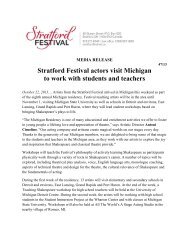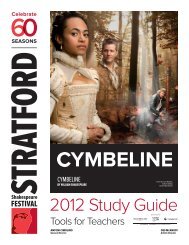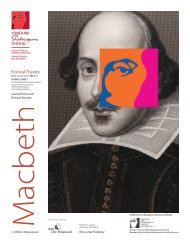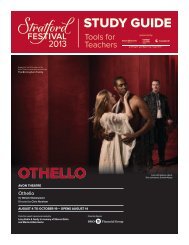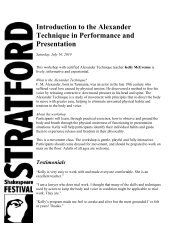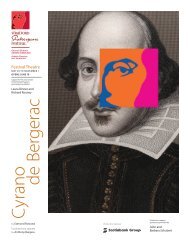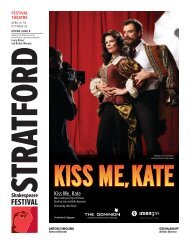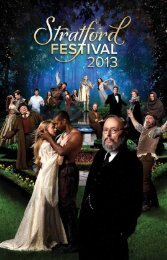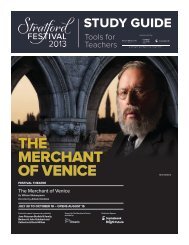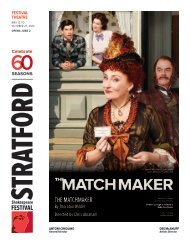ROMEO AND JULIET - Stratford Festival
ROMEO AND JULIET - Stratford Festival
ROMEO AND JULIET - Stratford Festival
You also want an ePaper? Increase the reach of your titles
YUMPU automatically turns print PDFs into web optimized ePapers that Google loves.
STUDY GUIDE<br />
Tools for<br />
Teachers<br />
sponsored by<br />
<strong>ROMEO</strong><br />
<strong>AND</strong> <strong>JULIET</strong><br />
Daniel Briere, Sara Topham<br />
FESTIVAL THEATRE<br />
Romeo and Juliet<br />
By William Shakespeare<br />
Directed by Tim Carroll<br />
MAY 1 TO OCTOBER 19 – OPENS MAY 27<br />
Production support is generously provided by<br />
Claire & Daniel Bernstein and M. Vaile Fainer<br />
Production Sponsor<br />
Additional funding generously provided by Members and patrons<br />
of the <strong>Stratford</strong> <strong>Festival</strong> and <strong>Stratford</strong> <strong>Festival</strong> of America.
Table of Contents<br />
The Place<br />
The <strong>Stratford</strong> <strong>Festival</strong> Story ........................................................................................ 1<br />
The Play<br />
The Playwright: William Shakespeare ........................................................................ 3<br />
A Shakespearean Timeline ......................................................................................... 4<br />
Cast of Characters ...................................................................................................... 6<br />
Plot Synopsis ............................................................................................................... 7<br />
Sources and Production History ................................................................................. 8<br />
The Production<br />
Artistic Team and Cast ............................................................................................... 10<br />
Lesson Plans and Activities<br />
Juliet’s Troubled Imaginations ........................................................................... 11<br />
Paris’ Soliloquy ..................................................................................................... 14<br />
The R & J Debates ............................................................................................... 16<br />
Discussion Topics ............................................................................................... 18<br />
Resources ..................................................................................................... 19
The<br />
<strong>Stratford</strong><br />
Story<br />
That <strong>Stratford</strong>, Ontario, is the home of<br />
the largest classical repertory theatre<br />
in North America is ultimately<br />
attributable to the dream of one man,<br />
<strong>Stratford</strong>-born journalist Tom<br />
Patterson.<br />
In the early 1950s, seeing the<br />
economy of his home town<br />
endangered by the withdrawal of the<br />
railway industry that had sustained it<br />
for nearly 80 years, Patterson<br />
conceived the idea of a theatre festival<br />
devoted to the works of William<br />
Shakespeare. His vision won the<br />
support not only of <strong>Stratford</strong> City<br />
Council and an enthusiastic committee<br />
of citizens, but also of the legendary<br />
British actor and director Tyrone<br />
Guthrie, who agreed to become the<br />
proposed festival’s first Artistic<br />
Director. The <strong>Stratford</strong> Shakespearean<br />
<strong>Festival</strong> of Canada was incorporated<br />
as a legal entity on October 31, 1952.<br />
A giant canvas tent was ordered from a<br />
firm in Chicago, and in the parklands<br />
by <strong>Stratford</strong>’s Avon River work began<br />
on a concrete amphitheatre at the<br />
centre of which was to be a<br />
revolutionary thrust stage created to<br />
Guthrie’s specifications by<br />
internationally renowned theatrical<br />
designer Tanya Moiseiwitsch.<br />
discontent/ Made glorious summer by<br />
this sun of York.” Those words marked<br />
the triumphant end to what had<br />
sometimes seemed a hopeless<br />
struggle against the odds to turn<br />
Patterson’s dream into a reality – and<br />
the beginning of an astonishing new<br />
chapter in Canadian theatre history.<br />
The other production of that inaugural<br />
six-week season, a modern-dress<br />
version of All’s Well That Ends Well,<br />
opened the following night, confirming<br />
the opinion of celebrated novelist<br />
Robertson Davies that the new <strong>Festival</strong><br />
was an achievement “of historic<br />
importance not only in Canada, but<br />
wherever theatre is taken seriously –<br />
that is to say, in every civilized country<br />
in the world.”<br />
Time proved the truth of Davies’<br />
words, for the <strong>Festival</strong>’s pillared,<br />
porticoed thrust stage revolutionized<br />
the performance of classical and<br />
contemporary theatre in the latter half<br />
of the 20th century and inspired the<br />
design of more than a dozen other<br />
major venues around the world,<br />
including the Guthrie Theatre in<br />
Minneapolis, the Beaumont Theatre at<br />
Lincoln Centre and, in England, the<br />
Chichester <strong>Festival</strong> Theatre, the<br />
Crucible Theatre in Sheffield and the<br />
Olivier Theatre at the Royal National<br />
Theatre in London. Over the years, the<br />
<strong>Festival</strong> has made some amendments<br />
to the original design of Moiseiwitsch’s<br />
stage, without changing its essential<br />
format.<br />
From the balcony of that stage, on the<br />
night of July 13, 1953, actor Alec<br />
Guinness spoke the opening lines of<br />
Richard III: “Now is the winter of our<br />
Romeo and Juliet<br />
Study Guide<br />
<strong>Stratford</strong> <strong>Festival</strong> 2013 1
At the<br />
end of the<br />
1956 season, the<br />
giant<br />
canvas tent that had housed the<br />
<strong>Festival</strong>’s first four seasons was<br />
dismantled for the last time<br />
to make<br />
way for a new and permanent facility<br />
to be<br />
erected around the existing<br />
stage. Designed by architect Robert<br />
Fairfield, the new<br />
building would be<br />
one of the most distinctive in the world<br />
of the<br />
performing arts: its circular floor<br />
plan and crenellated roof paying<br />
striking tribute to<br />
the <strong>Festival</strong>’s origins<br />
under canvas.<br />
In the<br />
years since its first season, the<br />
<strong>Stratford</strong> <strong>Festival</strong> has set benchmarks<br />
for the production not only of<br />
Shakespeare, Molière, the ancient<br />
Greeks and other great dramatists of<br />
the past, but also of such 20th-century<br />
masters as Samuel Beckett, Bertolt<br />
Brecht, Anton Chekhov, Henrik Ibsen,<br />
Eugene O’Neill and Tennessee<br />
Williams. In addition to acclaimed<br />
productions of the best in operetta and<br />
musical theatre, it has also<br />
showcased–andd in many cases<br />
premièred– works by outstanding<br />
Canadian and other contemporary<br />
playwrights.<br />
Its artists have included the<br />
finest<br />
actors, directors and designers in<br />
Canada, as well as many from abroad.<br />
Among the internationally renowned<br />
performers who<br />
have graced its stages<br />
are Alan Bates, Brian Bedford, Douglas<br />
Campbell, Len Cariou, Brent Carver,<br />
Hume Cronyn, Brian Dennehy, Colm<br />
Feore, Megan Follows, Lorne Greene,<br />
Paul Gross, Uta<br />
Hagen, Julie Harris,<br />
Martha Henry, William Hutt, James<br />
Mason, Eric McCormack, Loreena<br />
McKennitt, Richard Monette, John<br />
Neville, Nicholas Pennell, Christopher<br />
Plummer, Sarah Polley, Douglas Rain,<br />
Katee Reid, Jason Robards, Paul<br />
Scofield, William<br />
Shatner, Maggie<br />
Smith, Jessica Tandy, Peter Ustinov<br />
and Al Waxman.<br />
Drawing audiences of more<br />
than<br />
400,000 each year, the <strong>Festival</strong><br />
season now runs from April to<br />
November, with<br />
productions being<br />
presented in four unique theatres. It<br />
offers an extensive program<br />
of<br />
educational and<br />
enrichment activities<br />
for students, teachers and other<br />
patrons, and operates its own in-house<br />
school of professional artist<br />
development: The Birmingham<br />
Conservatory for Classical Theatre.<br />
<strong>Stratford</strong> <strong>Festival</strong> Behind the Scenes<br />
App. Contains interactive set models,<br />
exclusive images and slideshows,<br />
special audio and video content and<br />
photos, stories and animations and<br />
insights into the<br />
world of theatre at the<br />
<strong>Festival</strong>. For more information see<br />
www.stratfordfestival.ca/explore.<br />
For interactive classroom activities<br />
related to the <strong>Stratford</strong> <strong>Festival</strong>, go to<br />
the CBC Digital Archives:<br />
http: ://bit.ly/Yy7eK6<br />
Romeo and Juliet<br />
Study Guide<br />
<strong>Stratford</strong> <strong>Festival</strong> 2013 2
The Playwright:<br />
William Shakespeare<br />
Born in <strong>Stratford</strong>-upon-Avon, a small<br />
Warwickshire town, in 1564, William<br />
Shakespeare was the eldest son of John<br />
Shakespeare, a glover, and Mary Arden,<br />
the daughter of a wealthy farmer. The<br />
exact date of his birth is unknown, but<br />
baptismal records point to it being the<br />
same as that of his death, April 23. He<br />
probably attended what is now the Edward<br />
VI Grammar School, where he<br />
would have studied Latin literature, and<br />
at 18, he married a farmer’s daughter,<br />
Anne Hathaway, with whom he had three<br />
children: Susanna, born in 1583, and,<br />
two years later, the twins Hamnet (who<br />
died in childhood) and Judith.<br />
Nothing further is known of his life until<br />
1592, when his earliest known play, the<br />
first part of Henry VI, became a hit in London,<br />
where Shakespeare was now working<br />
as an actor. Soon afterwards, an outbreak<br />
of the plague forced the temporary<br />
closure of the theatres, and Shakespeare<br />
turned for a while to writing poetry. By<br />
1594, however, he was back in the theatre,<br />
acting with the Lord Chamberlain’s<br />
Men. He quickly established himself as<br />
one of London’s most successful dramatists,<br />
with an income that enabled him, in<br />
1597, to buy a mansion back in <strong>Stratford</strong>.<br />
In 1599 he became a shareholder<br />
in London’s newly built Globe Theatre.<br />
his death on April 23, 1616. He is buried<br />
in the town’s Holy Trinity Church.<br />
In the first collected edition of his works<br />
in 1623, fellow dramatist Ben Jonson<br />
called him a man “not of an age, but for<br />
all time”. Not only did Shakespeare write<br />
some of the most popular plays of all<br />
time, but he was a very prolific writer,<br />
writing 38 (canonically accepted) works<br />
in 23 years. His work covered many<br />
subjects and styles, including comedies,<br />
tragedies, histories and romances, all<br />
bearing his hallmark expansive plots, extraordinary<br />
language and humanist<br />
themes. Shakespeare enjoyed great popularity<br />
in his lifetime, and 400 years later,<br />
he is still the most produced playwright<br />
in the world.<br />
In 1603, Shakespeare’s company was<br />
awarded a royal patent, becoming known<br />
as the King’s Men. Possibly as early as<br />
1610, the playwright retired to his home<br />
in <strong>Stratford</strong>-upon-Avon, living there – and<br />
continuing to invest in real estate – until<br />
Romeo and Juliet<br />
Study Guide<br />
<strong>Stratford</strong> <strong>Festival</strong> 2013 3
A SHAKESPEAREAN TIMELINE<br />
1558 Elizabeth I crowned.<br />
1564 William Shakespeare born.<br />
1572 Actors not under the protection of a patron declared rogues and vagabonds.<br />
1576 “The Theatre”, the first public playhouse in London, opens.<br />
1577 “The Curtain”, London’s second playhouse, opens.<br />
1578 James VI (later James I of England) takes over government of Scotland.<br />
1579 Publication of North’s English translation of Plutarch’s Lives of the Noble Grecians and<br />
Romans.<br />
1580 Francis Drake returns in triumph form his voyage around the world; travelling players perform<br />
at <strong>Stratford</strong>.<br />
1582 Shakespeare marries Anne Hathaway; Susanna is born six months later and the twins<br />
Hamnet and Judith in 1585.<br />
1587 “The Rose” theatre opens in London. Mary Queen of Scots is executed.<br />
1588 Spanish Armada defeated.<br />
1589 Shakespeare finds work as an actor in London; he lives apart from his wife for 21 years.<br />
1590-1591 The Two Gentlemen of Verona, The Taming of the Shrew.<br />
1591 2 Henry VI, 3 Henry VI.<br />
1592 Thousands die of plague in London; theatres closed. 1 Henry VI, Titus Andronicus, Richard III.<br />
1593 The Comedy of Errors.<br />
1594 Shakespeare becomes a shareholder of his theatre company, The Lord Chamberlain’s Men.<br />
1594 Love’s Labour’s Lost.<br />
1595* Richard II, Romeo and Juliet, A Midsummer Night’s Dream.<br />
1596 Shakespeare’s son, Hamnet, dies.<br />
1596-1597 King John, The Merchant of Venice, 1 Henry IV.<br />
1597-1598 The Merry Wives of Windsor, 2 Henry IV, Much Ado About Nothing.<br />
1598 “The Globe” theatre built.<br />
1598-1599 Henry V, Julius Caesar.<br />
1599-1600 As You Like It.<br />
1600-1601 Hamlet, Twelfth Night.<br />
1601 Shakespeare’s patron arrested for treason following the Essex rebellion; he is later pardoned.<br />
1602 Troilus and Cressida.<br />
1603 Queen Elizabeth dies and is succeeded by James I; Shakespeare’s theatre company becomes<br />
the King’s Men.<br />
1603 Measure for Measure, Othello.<br />
1604 Work begins on the King James bible.<br />
1604-1605 All’s Well That Ends Well, Timon of Athens, King Lear (Q)<br />
1606 Macbeth, Antony and Cleopatra.<br />
Romeo and Juliet<br />
Study Guide<br />
<strong>Stratford</strong> <strong>Festival</strong> 2013 4
1607 Pericles, Prince of Tyre.<br />
1608 Coriolanus.<br />
1609 The Winter’s Tale.<br />
1610 King Lear (F), Cymbeline.<br />
1610 Shakespeare retires to <strong>Stratford</strong>-upon-Avon.<br />
1611 The Tempest.<br />
1611 King James version of the bible published.<br />
1613 Henry VIII (All is True), The Two Noble Kinsmen.<br />
1613 “The Globe” theatre burns down.<br />
1616 Shakespeare dies in <strong>Stratford</strong>-upon-Avon.<br />
1623 The first folio of Shakespeare’s collected plays is published.<br />
* some dates are approximate<br />
Romeo and Juliet<br />
Study Guide<br />
<strong>Stratford</strong> <strong>Festival</strong> 2013 5
CAST OF CHARACTERS<br />
Escalus, Prince of Verona<br />
Mercutio, a young gentleman and kinsman to the Prince, friend of Romeo<br />
Paris, a noble young kinsman to the Prince<br />
Page to Paris<br />
The Montagues<br />
Montague, head of a Veronese family at feud with the Capulets<br />
Lady Montague<br />
Romeo, Montague’s son<br />
Benvolio, Montague’s nephew and friend of Romeo and Mercutio<br />
Abram, a servant to Montague<br />
Balthasar, Romeo’s servant<br />
The Capulets<br />
Capulet, head of a Veronese family at feud with the Montagues<br />
Lady Capulet<br />
Juliet, Capulet’s daughter<br />
Tybalt, Lady Capulet’s nephew<br />
Cousin Capulet, an old gentleman<br />
Nurse, a Capulet servant, Juliet’s foster-mother<br />
Peter, a Capulet servant attending on the Nurse<br />
Sampson<br />
Gregory<br />
Anthony<br />
of the Capulet household<br />
Potpan<br />
Other Servingmen<br />
Friar Laurence<br />
Friar John of the Franciscan Order<br />
Apothecary of Mantua<br />
Musicians<br />
Members of the Watch, citizens of Verona, masquers, torchbearers, pages, servants<br />
Romeo and Juliet<br />
Study Guide<br />
<strong>Stratford</strong> <strong>Festival</strong> 2013 6
PLOT SYNOPSIS<br />
Two families of Verona, the Montagues and the Capulets, are embroiled in a long-standing<br />
feud. One night, Romeo, a Montague, gatecrashes a party being given by the Capulets, in<br />
hopes of encountering Rosaline, with whom he is infatuated. Thoughts of her are driven from<br />
his mind, however, when he catches sight of Juliet, the daughter of Lord Capulet. Juliet, who<br />
has been promised in marriage to Paris, is equally smitten with Romeo, and, with the help of<br />
Friar Lawrence, the two are secretly married. No sooner is the ceremony concluded, however,<br />
than Romeo is drawn in to a brawl, in which he kills Tybalt, Juliet’s cousin. Under sentence of<br />
banishment, Romeo spends the night with Juliet before going into hiding; meanwhile, Capulet<br />
orders Juliet to marry Paris within three days. Friar Lawrence devises a plan: Juliet will take a<br />
potion that will make her appear to be dead, allowing Romeo to steal into her family vault<br />
and rescue her when she revives. But the message informing Romeo of the plan goes astray<br />
and, believing Juliet to be truly dead, he commits suicide over her seemingly lifeless body.<br />
Awakening to find her lover dead beside her, Juliet too kills herself, leaving both families to<br />
mourn their children and abandon their feud.<br />
Check out this fun game and help Romeo rescue Juliet from the balcony <br />
http://www.kokogames.com/free-games/124/featured-games/149/romeo.htm<br />
Romeo and Juliet<br />
Study Guide<br />
<strong>Stratford</strong> <strong>Festival</strong> 2013 7
The Story of the Play<br />
Sources and Production History<br />
ABOUT THE PLAY<br />
One of the most famous love-stories of all time, Romeo and Juliet is a tragedy about an illfated<br />
romance between two young people caught in a bitter feud between their two families.<br />
Shakespeare is believed to have written the play between 1594 and 1595. It was popular<br />
enough in his own time to have spawned a printed, pirated version in 1597, whose title page<br />
proclaims it to be “An excellent conceited tragedy” that had “been often (with great<br />
applause) played publicly.”<br />
SOURCES <strong>AND</strong> ORIGINS<br />
The story was already well-know by Shakespeare’s time. His direct source was The Tragicall<br />
History of Romeus and Juliet (1562), a long narrative poem by Arthur Brooke, based on a<br />
prose fiction by Bandello (1554), which was itself derived from an earlier Italian story by Luigi<br />
da Porto (1530).<br />
<strong>ROMEO</strong> <strong>AND</strong> <strong>JULIET</strong> IN PERFORMANCE<br />
Franco Zeffirelli’s 1968 film version starring Leonard Whiting and Olivia Hussey is one of the<br />
most popular Shakespearean movies ever made. Other versions include George Cukor’s<br />
1936 film starring Norma Shearer and Leslie Howard.<br />
The famous Stephen Sondheim/Leonard Bernstein Broadway musical West Side Story was<br />
based on Romeo and Juliet. The film version of the musical (1961) starred Natalie Wood and<br />
Richard Beymer.<br />
1996’s William Shakespeare’s Romeo + Juliet, directed by Baz Luhrmann (Strictly Ballroom,<br />
Moulin Rouge), stars Claire Danes and Leonard DiCaprio as the lovers.<br />
STRATFORD FESTIVAL PRODUCTION HISTORY<br />
This is the ninth production of Romeo and Juliet at the <strong>Stratford</strong> <strong>Festival</strong>.<br />
1960 (<strong>Festival</strong> Theatre): directed by Michael Langham and designed by Tanya Moiseiwitsch.<br />
The cast included Bruno Gerussi as Romeo, Julie Harris as Juliet, William Needles as<br />
Benvolio, Christopher Plummer as Mercutio, Douglas Rain as Tybalt and Kate Reid as Nurse.<br />
1968 (<strong>Festival</strong> Theatre): directed by Douglas Campbell and designed by Carolyn Parker. The<br />
cast included Christopher Walken as Romeo, Louise Marleau as Juliet, Leo Ciceri as<br />
Mercutio, Amelia Hall as Nurse and Christopher Newton as Paris.<br />
1977 (Avon Theatre): directed by David William and designed by John Ferguson with Richard<br />
Monette as Romeo, Marti Maraden as Juliet, Florence Patterson as Nurse and Nicholas<br />
Pennell as Mercutio.<br />
Romeo and Juliet<br />
Study Guide<br />
<strong>Stratford</strong> <strong>Festival</strong> 2013 8
1984 (<strong>Festival</strong> Theatre): directed by Peter Dews and designed by John Ferguson. The cast<br />
included Colm Feore as Romeo, Seana McKenna as Juliet, Lewis Gordon as Friar Laurence,<br />
Elizabeth Leigh-Milne as Nurse, Stephen Russell as Paris and Richard Monette as Mercutio.<br />
1987 (Tom Patterson Theatre): directed by Robin Phillips and designed by Patrick Clark. The<br />
cast included Albert Schultz as Romeo, Susan Coyne as Juliet, Peter Donaldson as Capulet,<br />
and Nancy Palk as Nurse.<br />
1992 (<strong>Festival</strong> Theatre): directed by Richard Monette and designed by Debra Hanson. The<br />
cast included Antoni Cimolino as Romeo, Megan (Porter) Follows as Juliet, Barbara Bryne as<br />
Nurse, Colm Feore as Mercutio, Lewis Gordon as Capulet, Bernard Hopkins as Friar<br />
Lawrence and Kate Trotter as Lady Capulet.<br />
1997 (<strong>Festival</strong> Theatre): directed by Diana Leblanc and designed by Douglas Paraschuk (set)<br />
and Dany Lyne (costumes). The cast included Jonathan Crombie as Romeo, Marion Day as<br />
Juliet, Graham Abbey as Paris, Benedict Campbell as Friar Laurence, Diane D’Aquila as<br />
Nurse, Geordie Johnson as Mercutio, and Michael Mawson as Montague.<br />
2002 (<strong>Festival</strong> Theatre): directed by Miles Potter and designed by Patrick Clark. The cast<br />
included Graham Abbey as Romeo, Claire Jullien as Juliet, Wayne Best as Mercutio, Lally<br />
Cadeau as Nurse, Keith Dinicol as Friar Laurence, Sarah Dodd as Lady Montague, Caleb<br />
Marshall as Benvolio, Raymond O’Neill as Chorus/Escalus, Nicolas van Burek as Tybalt and<br />
Scott Wentworth as Capulet.<br />
2008 (<strong>Festival</strong> Theatre): directed by Des McAnuff and designed by Heidi Ettinger (set) and<br />
Paul Tazewell (costumes). The cast included Gareth Potter as Romeo, Nikki M. James as<br />
Juliet, Evan Buliung as Mercutio, Peter Donaldson as Friar Lawrence, Gordon S. Miller as<br />
Benvolio, Lucy Peacock as Nurse, John Vickery as Capulet and Sophia Walker as Lady<br />
Capulet.<br />
Romeo and Juliet<br />
Study Guide<br />
<strong>Stratford</strong> <strong>Festival</strong> 2013 9
THE PRODUCTION<br />
<strong>Festival</strong> Theatre<br />
May 1 – October 19<br />
Artistic Team<br />
Director. ........................ Tim Carroll<br />
Set Designer ................ Douglas Paraschuk<br />
Costume Designer ....... Carolyn M. Smith<br />
Lighting Designer ......... Kevin Fraser<br />
Composer ..................... Claudio Vena<br />
Sound Designer ........... Jim Neil<br />
Movement .................... Shona Morris<br />
Fight Director ............... John Stead<br />
Cast<br />
Escalus, Prince of Verona ............................................... Michael Blake<br />
Mercutio, friend of Romeo, kinsman to the Prince ....... Jonathan Goad<br />
Paris, a noble young kinsman to the Prince .................. Antoine Yared<br />
Page to Paris. ................................................................... Sara Farb<br />
The Montagues<br />
Montague, head of the family at feud with the Capulets .......... Wayne Best<br />
Lady Montague, his wife .............................................................. Gabrielle Jones<br />
Romeo, Montague’s son .............................................................. Daniel Briere<br />
Benvolio, Montague’s nephew .................................................... Skye Brandon<br />
Abraham, a servant to Montague ................................................ Robert King<br />
Balthasar, Romeo’s servant ........................................................ Andrew Lawrie<br />
The Capulets<br />
Capulet, head of the family at feud with the Montagues ......... Scott Wentworth<br />
Lady Capulet, his wife ................................................................. Nehassaiu deGannes<br />
Juliet, Capulet’s daughter ........................................................... Sara Topham<br />
Tybalt, Lady Capulet’s nephew ................................................... Tyrone Savage<br />
Old Capulet, an old gentleman ................................................... Sam Moses<br />
Nurse, a Capulet servant, Juliet’s nurse .................................... Kate Hennig<br />
Peter, a Capulet servant attending on the Nurse ...................... Mike Nadajewski<br />
Sampson, servant........................................................................ Brad Rudy<br />
Gregory, servant .......................................................................... Victor Ertmanis<br />
Friar Laurence .............................................................................. Tom McCamus<br />
Friar John ..................................................................................... Roy Lewis<br />
Musicians<br />
Apothecary, Citizens, Lords, Ladies: Jacquelyn French, Barbara Fulton, Valerie Hawkins,<br />
André Morin, Andrew Robinson, Sabryn Rock<br />
For more information and company bios visit: www.stratfordfestival.ca. You can also check<br />
out our <strong>Stratford</strong> for Students magazine at:<br />
http://www.stratfordfestival.ca/education/teachers.aspx?id=8609<br />
Romeo and Juliet<br />
Study Guide<br />
<strong>Stratford</strong> <strong>Festival</strong> 2013 10
Imaginative Ways to Approach the Text<br />
<strong>JULIET</strong>’S TROUBLED IMAGINATIONS<br />
Grade Level Grades 6-12<br />
Subject Areas Language Arts, English, Drama<br />
Ontario<br />
Curriculum<br />
Expectations<br />
By the end of the lesson students will be able to:<br />
Extend understanding of the text by connecting the ideas in them to<br />
their own knowledge, experience, insights and world around them.<br />
&<br />
Analyse the text, focusing on the ways in which they communicate<br />
Learning<br />
information and ideas and influence the listener’s/viewer’s<br />
Outcomes<br />
response.<br />
Use role play and characterization to explore issues in the play.<br />
Further develop the following:<br />
Speaking to Communicate<br />
Listening to Understand<br />
Reading for Meaning<br />
Drama: Creation<br />
Time Needed One class period<br />
Space<br />
Open space in the classroom<br />
Materials Handout<br />
Setting Up the Exercise:<br />
In this lesson, the students take a closer look at Juliet’s soliloquy in Act IV, scene 3.<br />
Review as a class what a soliloquy is and the reasons why Shakespeare employed<br />
this device in his plays.<br />
The Exercise:<br />
Hand out the one-page worksheet with Juliet’s speech already divided into nine<br />
sections.<br />
Choose nine people or divide the class into nine sections, each group responsible for<br />
a particular “troubled imagination.”<br />
Each group will devise a way to interpret and present their lines. They may do it as a<br />
choral piece or have one person saying the lines while the rest of the group forms a<br />
tableau to illustrate that particular troubled imagination.<br />
The rehearsal process will be two-tiered. At the beginning, each group will be given<br />
some time to rehearse their section. After that, have the students come together and<br />
inform student or group #1 that they will be up first and will present their section in<br />
the centre and are to remain there after they have completed their turn. The other<br />
students or groups will take their cues and position themselves in and around the<br />
circle according to what the last student or group has done and where they have<br />
positioned themselves in the circle.<br />
During the class presentation, have all nine students or groups stand in an open<br />
space in the classroom in a large circle. Have student or group #1 go to the centre<br />
and begin their piece using movement and/or incorporating choral speaking and<br />
finally becoming frozen sculptures at the end, followed by students or groups #2 – 9<br />
interweaving their interpretation of the text around student or group #1. (OPTIONAL:<br />
Have the students choose a piece of music to underscore the performance to help<br />
set the mood.)<br />
Romeo and Juliet<br />
Study Guide<br />
<strong>Stratford</strong> <strong>Festival</strong> 2013 11
For discussion:<br />
After the presentation, have the class discuss the questions listed below.<br />
o What did you discover after physically representing Juliet’s troubled<br />
imaginations?<br />
o Do you think Juliet’s troubled imaginations were real and she was right to be<br />
afraid? If so why or why not?<br />
o In performing Juliet’s dark fears, did you learn something new about her and<br />
her circumstances?<br />
Extensions:<br />
Write a letter in response to Juliet’s dark fears and offer some helpful suggestions to<br />
lessen her fear and comfort her.<br />
Draw, paint or create a collage of one of the dark fears that Juliet mentions. Write a<br />
caption to go with your visual presentation.<br />
Stage the soliloquy with one student playing Juliet and voicing section #1 while the<br />
rest (#2-9) voice her fears as ghosts haunting her troubled mind.<br />
Romeo and Juliet<br />
Study Guide<br />
<strong>Stratford</strong> <strong>Festival</strong> 2013 12
Romeo and Juliet - Act IV, scene 3<br />
Juliet’s Troubled Imaginations<br />
1. Farewell! God knows when we shall meet again.<br />
I have a faint cold fear thrills through my veins,<br />
That almost freezes up the heat of life:<br />
I'll call them back again to comfort me:<br />
Nurse! What should she do here?<br />
My dismal scene I needs must act alone.<br />
Come, vial.______________________________<br />
2. What if this mixture do not work at all?<br />
Shall I be married then to-morrow morning?<br />
No, no: this shall forbid it: lie thou there.<br />
3. What if it be a poison, which the Friar<br />
Subtly hath ministered to have me dead,<br />
Lest in this marriage he should be dishonoured,<br />
Because he married me before to Romeo?<br />
I fear it is: and yet, methinks, it should not,<br />
For he hath still been tried a holy man.<br />
4. How if, when I am laid into the tomb,<br />
I wake before the time that Romeo<br />
Come to redeem me? There's a fearful point!<br />
Shall I not, then, be stifled in the vault,<br />
To whose foul mouth no healthsome air breathes in,<br />
And there die strangled ere my Romeo comes?<br />
5. Or, if I live, is it not very like,<br />
The horrible conceit of death and night,<br />
Together with the terror of the place,--<br />
As in a vault, an ancient receptacle,<br />
Where, for these many hundred years, the bones<br />
Of all my buried ancestors are packed:<br />
6. Where bloody Tybalt, yet but green in earth,<br />
Lies festering in his shroud; where, as they say,<br />
At some hours in the night spirits resort;--<br />
7. Alack, alack, is it not like that I,<br />
So early waking, what with loathsome smells,<br />
And shrieks like mandrakes' torn out of the earth,<br />
That living mortals, hearing them, run mad:--<br />
O, if I wake, shall I not be distraught,<br />
Environed with all these hideous fears?<br />
8. And madly play with my forefather's joints?<br />
And pluck the mangled Tybalt from his shroud?<br />
And, in this rage, with some great kinsman's bone,<br />
As with a club, dash out my desperate brains?<br />
9. O, look! methinks I see my cousin's ghost<br />
Seeking out Romeo, that did spit his body<br />
Upon a rapier's point: stay, Tybalt, stay!<br />
Romeo, I come! this do I drink to thee.<br />
Laying down her dagger<br />
She falls upon her bed, within the curtains<br />
Romeo and Juliet<br />
Study Guide<br />
<strong>Stratford</strong> <strong>Festival</strong> 2013 13
Imaginative Ways to Approach the Text<br />
PARIS’S SOLILOQUY<br />
Grade Level Grades 7-12<br />
Subject Areas Language Arts, English, Drama<br />
Ontario<br />
Curriculum<br />
Expectations<br />
By the end of the lesson students will be able to:<br />
Develop and explain interpretations of the text, using evidence from the<br />
text.<br />
&<br />
Make and explain inferences, supporting their explanations with stated<br />
Learning<br />
and implied ideas from the text.<br />
Outcomes Use role play and characterization to explore issues in the play.<br />
Further develop the following:<br />
Speaking to Communicate<br />
Listening to Understand<br />
Reading for Meaning<br />
Drama: Creation<br />
Time Needed Two class periods<br />
Space<br />
Open space in the classroom upon presentation<br />
Materials Pencil/pen and notebook<br />
Romeo and Juliet script<br />
Setting Up the Exercise:<br />
In this lesson, the students will have the opportunity to create/write a soliloquy, using<br />
knowledge they have gained from either reading or seeing the production of Romeo<br />
and Juliet at the <strong>Stratford</strong> <strong>Festival</strong>.<br />
Review as a class what a soliloquy is and the reasons why Shakespeare employed<br />
this device in his plays.<br />
The Exercise:<br />
Review Act III, scene 4 and as a class, discuss the following: Paris has a very high<br />
status in Verona as he is related to Prince Escalus. The Capulets’ social standing,<br />
already significant, would be even more elevated if Juliet marries Paris. We know<br />
then that the Capulets would gain from this marriage, but what are Paris’s<br />
reasons/motives for this hasty marriage?<br />
Write a soliloquy for Paris, spoken upon his departure from the Capulets after having<br />
asked them for Juliet’s hand in marriage. Give reasons in this soliloquy why he wants<br />
to marry Juliet and soon.<br />
Have each student read or dramatically present their soliloquies to the class.<br />
Drama Extensions:<br />
Have students perform Act III, scene 4 and include their soliloquies.<br />
For Discussion:<br />
Why do you think Shakespeare did not give us a soliloquy or some form of further<br />
explanation as to Paris’s motives?<br />
Would you prefer that Paris had stated his motives in the play? Explain in detail and<br />
state why or why not.<br />
Romeo and Juliet<br />
Study Guide<br />
<strong>Stratford</strong> <strong>Festival</strong> 2013 14
Would you place your soliloquy at the beginning of Act III, scene 4 or at the end?<br />
Does it make a difference where it is placed? Note: The students may want to<br />
experiment with the placement of the soliloquy during their performance<br />
presentations.<br />
As you heard/saw each classmate’s soliloquy, were there common points or<br />
divergent points of view? Did some of the reasons given for wanting to marry Juliet<br />
surprise you, make you look at Paris in a more sympathetic light or less<br />
sympathetically?<br />
Romeo and Juliet<br />
Study Guide<br />
<strong>Stratford</strong> <strong>Festival</strong> 2013 15
Imaginative Ways to Approach the Text<br />
THE R & J DEBATES<br />
Grade Level Grades 7-12<br />
Subject Areas Language Arts, English, Drama<br />
Ontario<br />
Curriculum<br />
By the end of the lesson students will be able to:<br />
Identify and explain the important information and ideas of the text.<br />
Expectations Use a variety of drama conventions to establish a distinctive context or<br />
&<br />
role.<br />
Learning Analyse drama works to determine how they communicate ideas about<br />
Outcomes<br />
issues, culture and society.<br />
Further develop the following:<br />
Speaking to Communicate<br />
Listening to Understand<br />
Reading for Meaning<br />
Drama: Creation<br />
Time Needed Two class periods<br />
Space<br />
Open space in the classroom upon presentation<br />
Materials Pencil/pen and notebook<br />
Romeo and Juliet script<br />
Setting Up the Exercise:<br />
In this lesson, the students will have the opportunity to debate on a variety of<br />
controversial issues surrounding The Tragedy of Romeo and Juliet after reading<br />
and/or seeing the <strong>Stratford</strong> <strong>Festival</strong> production.<br />
Some of the topics that the class may choose from are listed below (or they may<br />
choose to come up with their own) [Note: Some of these are specific in nature and<br />
others are general.] :<br />
o A daughter must honour the wishes of her father at all times.<br />
o Juliet should marry Paris.<br />
o Banishment is preferable to death.<br />
o Mercutio is the superior swordsman to Tybalt.<br />
o Romeo and Juliet’s love was merely an infatuation.<br />
o Mercutio and the Nurse were unnecessary characters in the play.<br />
o Both Romeo and Juliet were too immature to get married.<br />
o The deaths of Romeo and Juliet were necessary to bring about the<br />
reconciliation between the Capulets and the Montagues.<br />
o Friar Laurence’s well-meaning interference caused more harm than good.<br />
The Exercise:<br />
For each topic, choose two teams: one team will be “for” the argument, and the other<br />
team will be “against” the argument put forth.<br />
As a class, decide on the length of each debate and number of rounds. For the rest of<br />
the class not involved in that particular debate, have them create a score card that<br />
rates each round for each team (e.g. from 1 to 5 with 1 being “weak argument” and<br />
5 being “exceptionally clear argument,” followed by one sentence stating the reasons<br />
for that score).<br />
Romeo and Juliet<br />
Study Guide<br />
<strong>Stratford</strong> <strong>Festival</strong> 2013 16
Each team will be responsible for creating an opening statement and supporting<br />
arguments, using evidence found in the text or production you have seen.<br />
Present each debate, with the rest of the class listening and filling out their score<br />
cards. Make sure to give sufficient time for the teams to confer before presenting<br />
their rebuttals. NOTE: The students may wish to debate as a character from the play<br />
or as themselves addressing the particular issues.<br />
For Discussion:<br />
After viewing/listening to the debates, have the class discuss questions listed below.<br />
o Were all of the arguments put forth, supported by the evidence from the text?<br />
o Do we get a sense of what is relevant to the plot by debating some of these<br />
issues?<br />
o What insights have you gained through these debates?<br />
o By looking at the pros and cons of various issues, what does this reveal about<br />
the characters?<br />
o If you were to stage a production of Romeo and Juliet what issues would you<br />
emphasize and highlight over others?<br />
Romeo and Juliet<br />
Study Guide<br />
<strong>Stratford</strong> <strong>Festival</strong> 2013 17
Discussion Topics for Your<br />
Class<br />
For classes reading the play before seeing it:<br />
1. What do you expect to see on stage at the <strong>Stratford</strong> <strong>Festival</strong>? Have each student<br />
make a list of predictions about what they expect. Save these predictions. After your<br />
<strong>Stratford</strong> trip, revisit them to see how they compared to the actual production.<br />
2. Have your students make a story map or a story board outlining the main events of<br />
the play. (This may be used later in group activities.)<br />
After your <strong>Stratford</strong> trip:<br />
1. Romeo and Juliet has appealed to artists and audiences around the world for 400<br />
years. What do you think the play’s message is?<br />
2. What parts did you respond to most?<br />
3. Were there parts you wished were different? How?<br />
4. Have your students create a character web showing how all the characters are<br />
connected to each other. Discuss the complexity of these relationships and how they<br />
affect the progression of the play.<br />
For more classroom activities, complete with instructions, materials and Ontario<br />
curriculum expectation links, visit stratfordfestival.ca/teachingmaterials.<br />
You can also check out the following:<br />
The Forum, a series of remarkable events to enrich the play-going experience:<br />
www.stratfordfestival.ca/forum/ .<br />
<strong>Stratford</strong> <strong>Festival</strong>’s YouTube channel for behind-the-scenes videos, photos<br />
and interviews: www.youtube.com/user/stratfordfestival<br />
<strong>Stratford</strong> <strong>Festival</strong>’s Flickr pages: www.flickr.com/photos/stratfest/<br />
<strong>Stratford</strong> <strong>Festival</strong> Twitter: twitter.com/stratfest<br />
<strong>Stratford</strong> <strong>Festival</strong> Facebook: www.facebook.com/<strong>Stratford</strong><strong>Festival</strong><br />
<strong>Stratford</strong> <strong>Festival</strong> Behind the Scenes App.: www.stratfordfestival.ca/explore.<br />
Romeo and Juliet<br />
Study Guide<br />
<strong>Stratford</strong> <strong>Festival</strong> 2013 18
Resources<br />
SHAKESPEARE: HISTORY, CRITICISM and BIOGRAPHY<br />
Beckerman, Bernard. Shakespeare and the Globe, 1599-1609. 1962.<br />
Bentley, G.E. Shakespeare: A Biographical Handbook. 1951.<br />
Boyce, Charles. Shakespeare A to Z. 1990.<br />
Brown, Ivor. Shakespeare and the Actors. 1970.<br />
Brown, John Russell. Shakespeare and his Theatre. 1993.<br />
Burgess, Anthony. Shakespeare. 1970.<br />
Campbell, Oscar James, ed. The Reader’s Encyclopedia of Shakespeare. 1966.<br />
Dobson, Michael, ed. The Oxford Companion to Shakespeare. 2001.<br />
Epstein, Norrie. The Friendly Shakespeare. 1992.<br />
Frye, R. M. Shakespeare’s Life and Times: a Pictorial Record. 1968.<br />
Gurr, Andrew. The Shakespearean Stage, 1574-1642. 1980.<br />
Hodges, C. Walter. Shakespeare and the Players. 1948.<br />
Muir, Kenneth and Samuel Schoenbaum, eds. A New Companion to Shakespeare<br />
Studies, 1985.<br />
Nagler, A. M. Shakespeare’s Stage. 1985.<br />
Schoenbaum, Samuel. William Shakespeare: A Documentary Life. 1975.<br />
Taylor, Gary. Reinventing Shakespeare. 1989.<br />
Thomson, Peter. Shakespeare’s Theatre. 1983.<br />
Tillyard, E. M. W. The Elizabethan World Picture. 1943.<br />
Wells, Stanley, ed. The Cambridge Companion to Shakespeare Studies. 1986.<br />
TEACHING SHAKESPEARE<br />
Asimov, Isaac. Asimov’s Guide to Shakespeare. New York, 1970.<br />
Edens, Walter, et al. Teaching Shakespeare. New Jersey: Princeton UP, 1977.<br />
Gibson, Rex. Secondary School Shakespeare. Cambridge: 1990.<br />
Gibson, Rex. Stepping into Shakespeare. Cambridge: 2000.<br />
Gibson, Rex and Field-Pickering, Janet. Discovering Shakespeare’s Language.<br />
Cambridge: 1998.<br />
O’Brien, Veronica. Teaching Shakespeare. London, 1982.<br />
<strong>ROMEO</strong> <strong>AND</strong> <strong>JULIET</strong><br />
Garfield, Leon. Shakespeare Stories. Puffin Books: 1985.<br />
Gibson, Rex. Teaching Shakespeare. 1998.<br />
Gibson, Rex & Field-Pickering, Janet. Discovering Shakespeare’s Language.<br />
Cambridge: 1998.<br />
Shakespeare, William. Romeo and Juliet, Arden (Third Series). 2012.<br />
Shakespeare, William. Romeo and Juliet. Cambridge School, 2nd Ed. 2007.<br />
Shakespeare, William. Romeo and Juliet. Oxford University Press, 1994.<br />
Romeo and Juliet<br />
Study Guide<br />
<strong>Stratford</strong> <strong>Festival</strong> 2013 19
Shakespeare, William. Romeo and Juliet. The Royal Shakespeare Company (The<br />
Modern Library). 2009.<br />
ONLINE RESOURCES<br />
BookRags.com Homepage, http://www.bookrags.com<br />
Mr. William Shakespeare and the Internet, shakespeare.palomar.edu<br />
Sh:in:E Shakespeare in Europe, www.unibas.ch/shine<br />
Encyclopaedia Britannica presents: Shakespeare and the Globe: Then and Now,<br />
search.eb.com/Shakespeare<br />
MIT Shakespeare Homepage: The Complete Works of William Shakespeare, thetech.mit.edu/Shakespeare/<br />
Shakespeare’s Life and Times,<br />
web.uvic.ca/shakespeare/Library/SLT/intro/introsubj.html<br />
Shakespeare Online, www.shakespeare-online.com<br />
Movie Review Query Engine, www.mrqe.com<br />
Internet Movie Database, www.imdb.com<br />
<strong>ROMEO</strong> <strong>AND</strong> <strong>JULIET</strong> ON FILM, VIDEO <strong>AND</strong> DVD<br />
1968 (UK): Romeo and Juliet. Directed by Franco Zeffirelli; starring Leonard<br />
Whiting and Olivia Hussey.<br />
1978 (UK-TV): Romeo and Juliet. Directed by Alvin Rakoff; starring Patrick<br />
Ryecart, Rebecca Saire, John Gielgud and Alan Rickman.<br />
1993 (CDA): Romeo and Juliet. Directed by Richard Monette; starring Antoni<br />
Cimolino, Megan Follows and Colm Feore. [The <strong>Stratford</strong> <strong>Festival</strong>’s<br />
production on film.]<br />
1994 (documentary film / PBS, CBC, NFB, WDR): Romeo and Juliet in Sarajevo.<br />
Directed by John Zaritsky. The tragic story of real-life lovers BoŠko Brkič<br />
and Admira Ismić, who died in Sarajevo during the civil war in Yugoslavia.<br />
1996 (USA): Romeo + Juliet. Directed by Baz Luhrmann; starring Leonardo<br />
DiCaprio and Claire Danes.<br />
Romeo and Juliet<br />
Study Guide<br />
<strong>Stratford</strong> <strong>Festival</strong> 2013 20



